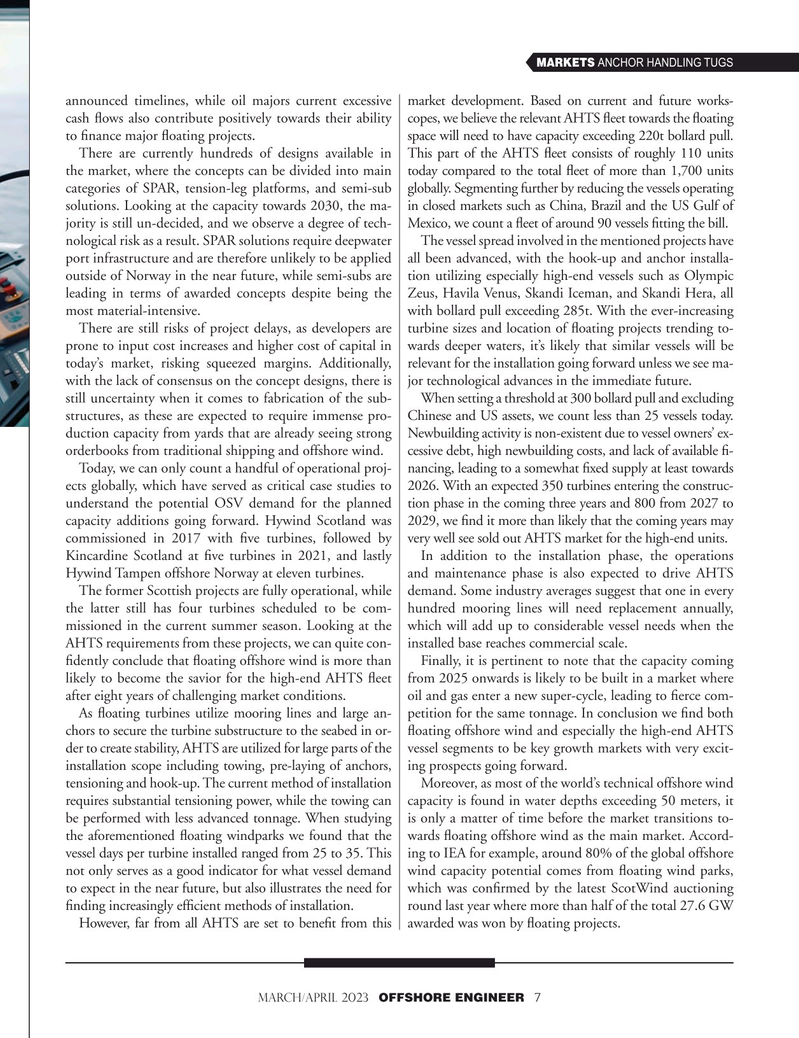
Page 7: of Offshore Engineer Magazine (Mar/Apr 2023)
Read this page in Pdf, Flash or Html5 edition of Mar/Apr 2023 Offshore Engineer Magazine
MARKETS ANCHOR HANDLING TUGS announced timelines, while oil majors current excessive market development. Based on current and future works- cash fows also contribute positively towards their ability copes, we believe the relevant AHTS feet towards the foating to fnance major foating projects. space will need to have capacity exceeding 220t bollard pull.
There are currently hundreds of designs available in This part of the AHTS feet consists of roughly 110 units the market, where the concepts can be divided into main today compared to the total feet of more than 1,700 units categories of SPAR, tension-leg platforms, and semi-sub globally. Segmenting further by reducing the vessels operating solutions. Looking at the capacity towards 2030, the ma- in closed markets such as China, Brazil and the US Gulf of jority is still un-decided, and we observe a degree of tech- Mexico, we count a feet of around 90 vessels ftting the bill. nological risk as a result. SPAR solutions require deepwater The vessel spread involved in the mentioned projects have port infrastructure and are therefore unlikely to be applied all been advanced, with the hook-up and anchor installa- outside of Norway in the near future, while semi-subs are tion utilizing especially high-end vessels such as Olympic leading in terms of awarded concepts despite being the Zeus, Havila Venus, Skandi Iceman, and Skandi Hera, all most material-intensive. with bollard pull exceeding 285t. With the ever-increasing
There are still risks of project delays, as developers are turbine sizes and location of foating projects trending to- prone to input cost increases and higher cost of capital in wards deeper waters, it’s likely that similar vessels will be today’s market, risking squeezed margins. Additionally, relevant for the installation going forward unless we see ma- with the lack of consensus on the concept designs, there is jor technological advances in the immediate future. still uncertainty when it comes to fabrication of the sub- When setting a threshold at 300 bollard pull and excluding structures, as these are expected to require immense pro- Chinese and US assets, we count less than 25 vessels today. duction capacity from yards that are already seeing strong Newbuilding activity is non-existent due to vessel owners’ ex- orderbooks from traditional shipping and offshore wind. cessive debt, high newbuilding costs, and lack of available f-
Today, we can only count a handful of operational proj- nancing, leading to a somewhat fxed supply at least towards ects globally, which have served as critical case studies to 2026. With an expected 350 turbines entering the construc- understand the potential OSV demand for the planned tion phase in the coming three years and 800 from 2027 to capacity additions going forward. Hywind Scotland was 2029, we fnd it more than likely that the coming years may commissioned in 2017 with fve turbines, followed by very well see sold out AHTS market for the high-end units.
Kincardine Scotland at fve turbines in 2021, and lastly In addition to the installation phase, the operations
Hywind Tampen offshore Norway at eleven turbines. and maintenance phase is also expected to drive AHTS
The former Scottish projects are fully operational, while demand. Some industry averages suggest that one in every the latter still has four turbines scheduled to be com- hundred mooring lines will need replacement annually, missioned in the current summer season. Looking at the which will add up to considerable vessel needs when the
AHTS requirements from these projects, we can quite con- installed base reaches commercial scale. fdently conclude that foating offshore wind is more than Finally, it is pertinent to note that the capacity coming likely to become the savior for the high-end AHTS feet from 2025 onwards is likely to be built in a market where after eight years of challenging market conditions. oil and gas enter a new super-cycle, leading to ferce com-
As foating turbines utilize mooring lines and large an- petition for the same tonnage. In conclusion we fnd both chors to secure the turbine substructure to the seabed in or- foating offshore wind and especially the high-end AHTS der to create stability, AHTS are utilized for large parts of the vessel segments to be key growth markets with very excit- installation scope including towing, pre-laying of anchors, ing prospects going forward.
tensioning and hook-up. The current method of installation Moreover, as most of the world’s technical offshore wind requires substantial tensioning power, while the towing can capacity is found in water depths exceeding 50 meters, it be performed with less advanced tonnage. When studying is only a matter of time before the market transitions to- the aforementioned foating windparks we found that the wards foating offshore wind as the main market. Accord- vessel days per turbine installed ranged from 25 to 35. This ing to IEA for example, around 80% of the global offshore not only serves as a good indicator for what vessel demand wind capacity potential comes from foating wind parks, to expect in the near future, but also illustrates the need for which was confrmed by the latest ScotWind auctioning fnding increasingly effcient methods of installation. round last year where more than half of the total 27.6 GW
However, far from all AHTS are set to beneft from this awarded was won by foating projects.
MARCH/APRIL 2023 OFFSHORE ENGINEER 7

 6
6

 8
8